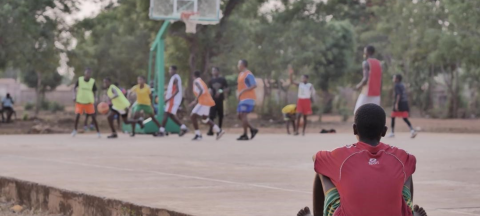
GCED Basic Search Form
Quick Search
You are here
News

Despite the growing momentum around sport for development, it remains an underutilized tool, particularly as it relates to educational development objectives. To commemorate the April 6th International Day of Sport for Development and Peace, we take an in-depth look at how sport for development can be used to effectively address SDG4 and help “ensure inclusive and equitable quality education and promote lifelong learning opportunities for all.”
Sport for Development (SFD) in addressing the SDGs
The April 6th International Day of Sport for Development and Peace, mandated by the United Nations General Assembly in 2013, was created as part of a larger initiative in “recognizing the transformative power of sport and its great potential in advancing positive social change”. Sport is similarly recognized by the 2030 Agenda for Sustainable Development as an “important enabler of sustainable development.” During the UNESCO Sixth International Conference of Ministers and Senior Officials Responsible for Physical Education and Sport (MINEPS VI-Kazan 2017), sport was officially recognized as a tool to address 10 of the 17 Sustainable Development Goals with the most relevant listed below:
- SDG 3: Good Health and Well Being
- SDG 4: Quality Education
- SDG 5: Gender Equality
- SDG 8: Decent Work and Economic Growth
- SDG 10: Reduce inequality
- SDG 11: Sustainable Cities and Communities
- SDG 16: Peace, Justice, and Strong Institutions
Sport for Development plays an important role in Educational Development Goals
In addressing SDG4, sport proves to be an innovative tool in that it is cross-cutting, and engages students in both formal and informal educational environments in a way that traditional teaching methods cannot. Accordingly, the Kazan Action Plan documents particularly influential ways in which sport tackles educational development goals:
- Physical Education and sport are “Fundamental rights for all” and important components of equitable and quality education (SDG 4.1)
- Quality physical education and sport learning environments contribute to broader educational outcomes (SDG 4.7)
- Sport promotes transferable soft-skills (leadership, discipline, empathy, respect) and improves school attendance (SDG 4.5)
- Sport provides experiential and empowering education and engages a diverse range of students (SDG 5.1)
- Sport contributes to eliminative gender disparities through inclusive and equitable delivery of sport programs (SDG 4.5)
- Sport promotes holistic development and life-long learning, and is a platform to develop leadership skills to promote sustainable development (SDG 4.7).

Sport for Development initiatives with an educational focus
Non-Governmental Organizations (NGOs) are pioneering the use of sport to address educational development goals, providing a pertinent example to the ecosystem of development actors as to just how powerful this tool can be. These NGOs are leveraging sport in a variety of ways, increasing school participation, tackling psychological barriers to increase educational achievement, or even teaching STEM through sport. Three NGOs in particular, Right to Play, RUN, and MLSE LaunchPad, demonstrate diverse and successful development strategies within the education sector.
Right to Play in partnership with the French Development Agency (Agence Française de Développement) is using sport as part of their “Playdagogy” methodology as a way to keep Burundian children in school. The “Playdagogy” methodology works as a participatory strategy that “uses sports games to raise children’s awareness of the importance of school, but also to dismantle stereotypes around poverty, gender, or disability”. The “Playdagogy” strategy has impacted over 10,000 Burundian children. It also has grassroots programs in Haiti, India, and Kosovo among other locations.
In Hong Kong, the non-profit organization, RUN, has intertwined sport and education to help rehabilitate adult refugees and asylum seekers that have been denied access to education. RUN does this by providing sport opportunities as a means to help participants overcome psychological challenges. In addition, RUN provides online educational programs along with IT and healthcare training courses for participants, believing that educational empowerment will ultimately lead to increased employment opportunities. As a newly created NGO, RUN has seen tremendous success with over 79% of participants reporting “being calm, peaceful and happy after hiking/fitness” and having gained newly acquired skills and knowledge through online education.
The innovative Sport + STEM program, implemented by MLSE LaunchePad and Visions of Science Network for Learning Inc., leverages sports as a pedagogical tool to teach Science Technology Engineering and Math concepts delivered entirely through hands-on sport activities. The program works by linking each one of MLSEs four core concepts, “ecosystems, block chain coding, design thinking and geometry,” to specific sport curriculum linked to the sports of basketball, hockey, soccer and football. Within just six short-months of its inauguration, over 200 youth (aged six-29) have seen significant increases in STEM educational achievement levels with “89% of participants stated that it was easier to learn new concepts through sport than in a classroom,” and “94% of participants reporting that the soccer activities helped them to better understand ecosystems.”
Education and Sport for Development in the future
The recently created Kazan Action Plan (2017) highlights the importance of sport, particularly as it relates to educational initiatives within the 2030 Agenda for Sustainable Development. Furthermore, we’ve seen how NGOs are innovatively leveraging sport to address SDG4. What is lacking, however, is a serious application of sport within the more formal education sector. This gap is likely the result of a shortage of robust research and indicators within the field of sport for development in addressing educational goals. More research and proper monitoring and evaluation of SFD projects is needed in order for sport to play a more serious role at the service of SDG4 and other goals. Additionally, national sport ministries and education ministries would be wise to engage in cross-sectoral coordination in order for sport to be more integrated within formal educational strategies. Nevertheless, the growing momentum around Sport for Development presents exciting opportunities for how sport can be innovatively employed in the advancement of educational development objectives.
URL:
https://learningportal.iiep.unesco.org/en/blog/sport-for-development-addressing-sdg-4
